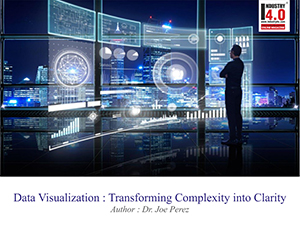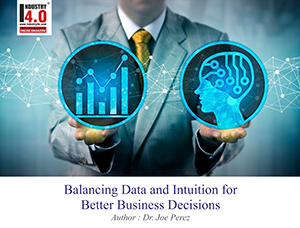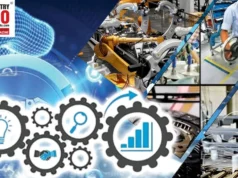Data Visualization: Transforming Complexity into Clarity for
Non-Technical Audiences
PART – 2
INTRODUCTION : Navigating the Data Labyrinth
In the dynamic and rapidly evolving realm of data-driven decision-making, organizations across diverse industries are recognizing the transformative power of data as a strategic asset. Decision-makers, often lacking technical expertise, rely on data analysts and data scientists to bridge the gap between raw data and actionable insights, enabling informed strategic choices that drive organizational success.
This journey from data to decision, however, is not a simple linear process. It demands a systematic approach that harmonizes technical expertise with a deep understanding of the business context. This process encompasses several key steps, each playing a crucial role in transforming data into a powerful tool for decision-making.
PART 1 of this article dives into the art of crafting compelling data visualizations that effectively communicate key insights to a non-technical audience. We explore the principles of simplicity, clarity, and context, empowering you to create data visualizations that not only inform but also inspire.
Effective data visualization transcends mere data presentation; it’s about storytelling with data. By carefully selecting chart types, employing clear labeling, and utilizing visual cues, we can guide the audience’s attention towards the most important takeaways, ensuring that the data speaks for itself.
To browse PART – 1
In Part 2 here we will focus on bridging the gap between data analysts and decision-makers. We explore the importance of user-centric storytelling and the strategies for effectively communicating actionable insights to non-technical decision-makers.
Data analysts and data scientists often find themselves serving as translators, transforming complex data into clear and actionable narratives that resonate with decision-makers’ priorities and decision-making processes. By employing storytelling techniques, leveraging visual storytelling, and tailoring the message to the audience’s needs, we can effectively bridge the gap between data and decision-making.
Whether you’re a data analyst striving to engage a non-technical audience or a decision-maker seeking to harness the power of data, this comprehensive guide provides the tools and strategies to transform data into a catalyst for informed decision-making. Embrace the power of data visualization, bridge the gap between data and understanding, and embark on a journey towards informed choices, innovation, and success.
Bridging the Gap: Communicating Actionable Insights to Non-Technical Decision-Makers
In the dynamic world of data-driven decision-making, extracting actionable insights from raw data is only half the battle. The other crucial step is effectively communicating these insights to decision-makers, who may not possess technical expertise. After all, the most insightful data analysis is rendered useless if it fails to resonate with the individuals who need it most.
In the previous section, we explored the systematic process of transforming data into actionable insights. Now, we’ll focus on the art of effectively communicating these insights to non-technical decision-makers. This requires a delicate balance between technical accuracy and clear, user-centric storytelling.
Decision-makers are diverse individuals with expertise in their respective domains, often focused on the strategic direction and day-to-day operations of their organizations. As data communicators, our task lies in bridging the gap between their world and the world of data. We must translate complex insights into actionable narratives that resonate with their priorities and decision-making processes.
The effectiveness of storytelling in communicating data is further supported by research conducted by Daniel Kahneman and Amos Tversky. Their work on behavioral economics highlighted the influence of narrative structure and emotional appeal on decision-making. They demonstrated that people are more likely to be persuaded by data presented in a compelling story format than by dry, numerical presentations.
To that point, in the dynamic and ever-evolving realm of data-driven decision-making, the ability to transform raw data into actionable insights has become an indispensable asset for organizations across various industries. Decision-makers, often non-technical themselves, rely on data analysts and data scientists to bridge the gap between data and understanding, extracting valuable insights that inform strategic choices and drive organizational success.
This journey from data to decision, however, is not always straightforward. It demands a systematic approach that embraces both technical expertise and a deep understanding of the business context. The process involves several key steps, each playing a crucial role in transforming data into a powerful tool for decision-making.
The first step in this transformative journey is to clearly define the problem or issue at hand. This involves understanding the business objectives, identifying the root cause of the problem, and asking the right questions: What decisions need to be made? What data is relevant to the decision-making process? By establishing a clear understanding of the problem, we set the stage for a focused and effective analysis.
With the problem clearly defined, we embark on the critical task of data collection. This may involve extracting data from internal databases, acquiring data from external sources, or conducting surveys and experiments. The more comprehensive the data collection, the better equipped we are to uncover hidden patterns and trends within the data.
Much of the data collected often exists in its raw, unrefined form. Before unleashing the power of analysis, we must first transform this raw data into a usable format. This involves cleaning the data by addressing missing values, removing duplicates, and ensuring consistency across disparate sources. Data cleaning and preparation are essential steps that lay the groundwork for reliable and meaningful analysis.
With the data clean and prepared, we delve into the realm of exploratory data analysis. This involves creating visualizations, calculating summary statistics, and identifying correlations. Through these techniques, we begin to uncover patterns and relationships within the data, gaining a deeper understanding of its underlying structure.
Building upon the preliminary insights gained from exploratory data analysis, we move on to data modeling. This involves creating statistical or machine learning models that capture the complexities of the data. These models serve as powerful tools for uncovering hidden patterns, predicting future trends, and gaining even deeper insights into the data.
Before relying on the insights derived from data models, we must validate their accuracy and reliability. This involves using appropriate validation methods to assess the performance of the models and ensure that they can be trusted to provide reliable insights.
Once the models have been validated, we can finally extract the valuable insights hidden within the data. These insights, often presented through visualizations and presentations, provide decision-makers with a clear understanding of the data’s implications and inform strategic choices.
The ultimate goal of the data-to-decision journey is to translate insights into actionable steps. This involves utilizing the insights to inform decisions, implement changes to processes or systems, and launch new initiatives. Whatever the case, the insights gained from data analysis should drive meaningful action that aligns with organizational objectives.
While the steps outlined above provide a structured approach to transforming data into actionable insights, it is important to recognize that this is an iterative process. As new data becomes available, as business needs evolve, and as technological advancements emerge, the process may need to be adapted to accommodate these changes.
Data analysts and data scientists play a crucial role in navigating this data-to-decision journey. Their expertise in data collection, analysis, and modeling enables them to bridge the gap between raw data and actionable insights. They serve as trusted advisors to decision-makers, providing them with the insights they need to make informed choices that drive organizational success.
CONCLUSION:
Data-Driven Decision-Making (A Catalyst for Organizational Excellence)
In today’s data-driven world, the ability to transform data into actionable insights has become a competitive advantage for organizations across various industries. By embracing a systematic and data-driven approach to decision-making, organizations can gain a deeper understanding of their customers, markets, and operations, enabling them to make informed choices that optimize performance, enhance customer satisfaction, and drive sustainable growth.
This systematic approach to data-driven decision-making encompasses not only the technical expertise of data analysts and data scientists but also the art of effectively communicating data insights to non-technical decision-makers. Data visualization and storytelling techniques play a crucial role in bridging the gap between data and understanding, ensuring that the insights derived from complex analyses resonate with those who need them most.
Data is not merely a collection of numbers; it is a repository of untapped potential, waiting to be transformed into actionable knowledge. As renowned data scientist and author Drew Conway eloquently stated, “Data is not an asset; it’s a liability if not used correctly.” By effectively transforming data into actionable insights and communicating them in a clear and compelling manner, organizations can unlock the hidden potential within their data, propelling them towards a future of informed choices, innovation, and success.
Effective data communication is not just about presenting data in a visually appealing format; it is about crafting narratives that resonate with the audience’s priorities and decision-making processes. By employing storytelling techniques, leveraging visual storytelling, and tailoring the message to the audience’s needs, we can empower non-technical decision-makers to grasp the essence of data and make informed choices that drive organizational excellence.
Data-driven decision-making, when coupled with effective communication strategies, empowers organizations to navigate the complexities of the modern business landscape. By bridging the gap between data and understanding, organizations can make informed strategic choices that optimize performance, enhance customer satisfaction, and drive sustainable growth. As data continues to permeate every aspect of our lives, the ability to transform it into actionable insights and communicate them effectively will remain a critical differentiator for organizations seeking to thrive in the data-driven era.
REFERENCES:
Chandler, P., & Sweller, J. (1992). Cognitive load during problem solving: A comparison of learning conditions in novice learners. Journal of Experimental Psychology: Learning, Memory, and Cognition, 18(4), 1052-1071.
Snow, J. (1855). On the mode of communication of cholera. London: John Churchill.
Kahneman, D., & Tversky, A. (2002). Judgment under uncertainty: Heuristics and biases. Cambridge University Press.
“Bringing Data to Life and Life to Data”
About the Author:

Dr. Joe Perez,
Team Lead / Senior Systems Analyst,
NC Department of Health and Human Services
Dr. Joe Perez ( Dr.Joe ) is also the Chief Technology Officer – SolonTek
Dr. Joe Perez is a truly exceptional professional who has left an indelible mark on the IT, health and human services, and higher education sectors. His journey began in the field of education, where he laid the foundation for his career. With advanced degrees in education and a doctorate that included a double minor in computers and theology, Joe embarked on a path that ultimately led him to the dynamic world of data-driven Information Technology.
In the early 1990s, he transitioned into IT, starting as a Computer Consultant at NC State University. Over the years, his dedication and expertise led to a series of well-deserved promotions, culminating in his role as Business Intelligence Specialist that capped his 25 successful years at NC State. Not one to rest on his laurels, Dr. Perez embarked on a new challenge in the fall of 2017, when he was recruited to take on the role of Senior Business Analyst at the NC Department of Health & Human Services (DHHS). His impressive journey continued with promotions to Senior Systems Analyst and Team Leader, showcasing his versatility and leadership capabilities.
In addition to his full-time responsibilities at DHHS, Joe assumed the role of fractional Chief Technology Officer at a North Carolina corporation in October 2020. A top-ranked published author with over 16,000 followers on LinkedIn and numerous professional certifications, he is a highly sought-after international keynote speaker, a recognized expert in data analytics and visualization, and a specialist in efficiency and process improvement.
Dr. Perez’s contributions have not gone unnoticed. He is a recipient of the IOT Industry Insights 2021 Thought Leader of the Year award and has been acknowledged as a LinkedIn Top Voice in multiple topics. He holds memberships in prestigious Thought Leader communities at Gartner, Coruzant Technologies, DataManagementU, Engatica, the Global AI Hub, and Thinkers360 (where he achieved overall Top 20 Thought Leader 2023 ranking in both Analytics and Big Data). His reach extends to more than twenty countries worldwide, where he impacts thousands through his speaking engagements.
Beyond his professional achievements, Joe’s passion for teaching remains undiminished. Whether as a speaker, workshop facilitator, podcast guest, conference emcee, or team leader, he continually inspires individuals to strive for excellence. He treasures his time with his family and is a gifted musician, singer, pianist, and composer. Joe also dedicates his skills as a speaker, interpreter, and music director to his church’s Hispanic ministry. He manages the publication of a widely recognized monthly military newsletter, The Patriot News, and is deeply committed to his community.
To maintain a balanced life, Perez is a regular at the gym, and he finds relaxation in watching Star Trek reruns. He lives by the philosophy that innovation is the key to progress, and he approaches each day with boundless energy and an unwavering commitment to excellence. His journey is a testament to the remarkable achievements of a truly exceptional individual.
Dr.Joe Perez is Accorded with the following Honors & Awards :
https://www.linkedin.com/in/jw
Dr. Joe Perez is Bestowed with the following Licences,Certifications & Badge:
https://www.linkedin.com/in/jw
https://www.thinkers360.com/tl
Dr.Joe Perez is Voluentering in the following International Industry Associations & Institutions :
https://www.linkedin.com/in/jw
Dr.Joe Perez can be contacted at :
E-mail | LinkedIn | Web | Sessionize | FaceBook | Twitter | YouTube
Also read Dr.Joe Perez‘s earlier article:
















